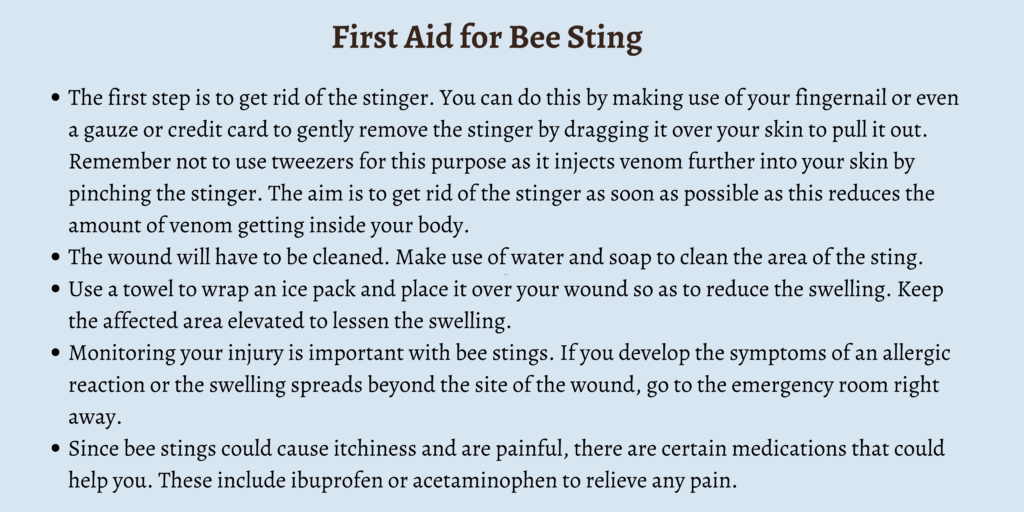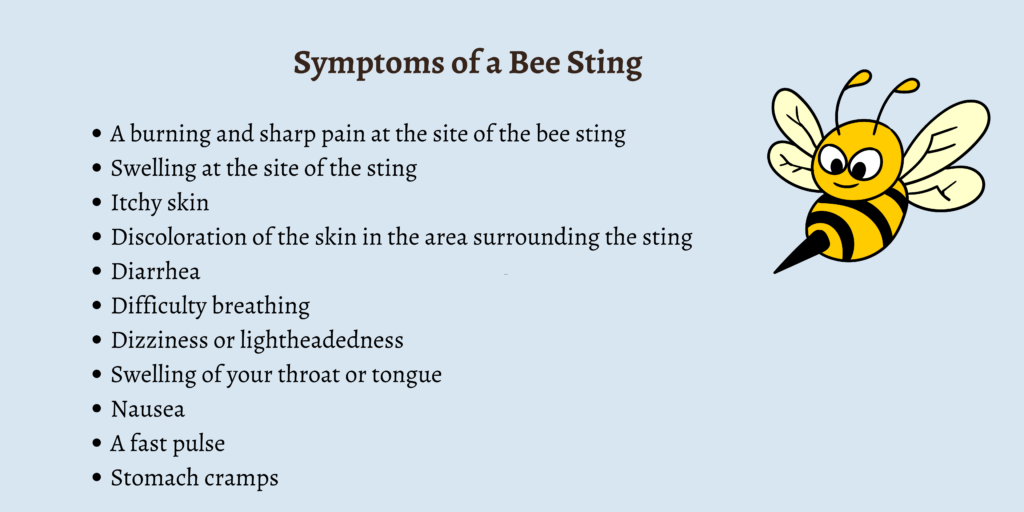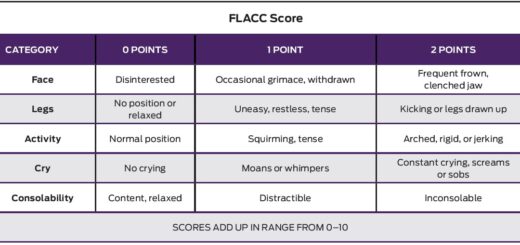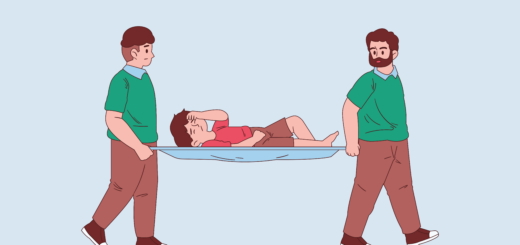First Aid for Bee Sting: 5 Effective Relief Tips
More than 500,000 people in the United States get stung by bees every year. While in some cases bee stings just cause a bit of nuisance and can be dealt with through home remedies, in other cases, they could cause reactions that call for emergency treatment.
Although you may not be allergic to bee stings, you could come across people who are, which is why I believe knowing about the treatment associated with bee stings is crucial.
Bee stings are wounds that are caused by bees. These creatures have a thorn-shaped organ known as a stinger which they make use of to sting you. When someone gets stung by a bee, the stinger gets detached from its body and sticks to the skin.
There is venom inside a bee’s stinger, which some people are allergic to. Having an allergic reaction to a bee sting could be life-threatening if the victim isn’t given immediate medical attention.
Do you know what to do if someone gets stung by a bee? If not, then we’re here to cover it all here today. In this article, we will be discussing the symptoms and risk factors of bee stings, the first aid for a bee sting, the helpful home remedies, and how to diagnose and prevent them.
Symptoms of a Bee Sting
The following are the symptoms of a bee sting:
- A burning and sharp pain at the site of the bee sting.
- Swelling at the site of the sting.
- Itchy skin.
- Discoloration of the skin in the area surrounding the sting.
Victims could also have a serious allergic reaction to a bee sting, the term for which is anaphylaxis. When you suffer from such an allergic reaction, the symptoms of it could be:
- Diarrhea
- Difficulty breathing
- Dizziness or lightheadedness
- Swelling of your throat or tongue
- Nausea
- A fast pulse
- Stomach cramps
Risk Factors
The risk of experiencing a bee sting could amplify under the following circumstances:
- If you wear perfume.
- If you attempt to destroy or remove a beehive or nest.
- If you play or work outdoors close to flowering trees, a garden, or a nest or hive.
- If you harvest honey from bee hives.
- If you wear brightly colored clothes while being outdoors.
Diagnosis of a Bee Sting
Most victims won’t require to be checked by a healthcare provider due to a mild bee sting unless it leads to an allergic reaction. When you do suffer from such a reaction, that’s when you need to visit a doctor.
Your healthcare provider could recommend any of these two tests to check how your body – particularly your immune system – reacts to bee venom:
- Skin allergy test: For this procedure, your skin will be injected with a small amount of bee venom. If you are allergic to bee stings, you will see a bump develop on the site of the sting. You will then be monitored by your healthcare provider to see how your condition progresses.
- Blood allergy test: In this test, you will be required to give a small blood sample, which will be taken from your vein to get taken for a lab test. This blood test will help determine how the antibodies present in your blood respond to an allergen.
First Aid for Bee Sting

If someone gets stung by a bee, here are the steps to take as first aid so as to experience relief:
- The first step is to get rid of the stinger. You can do this by making use of your fingernail or even a gauze or credit card to gently remove the stinger by dragging it over your skin to pull it out. Remember not to use tweezers for this purpose as it injects venom further into your skin by pinching the stinger. The aim is to get rid of the stinger as soon as possible as this reduces the amount of venom getting inside your body.
- The wound will have to be cleaned. Make use of water and soap to clean the area of the sting.
- Use a towel to wrap an ice pack and place it over your wound so as to reduce the swelling. Keep the affected area elevated to lessen the swelling.
- Monitoring your injury is important with bee stings. If you develop the symptoms of an allergic reaction or the swelling spreads beyond the site of the wound, go to the emergency room right away.
- Since bee stings could cause itchiness and are painful, there are certain medications that could help you. These include ibuprofen or acetaminophen to relieve any pain.
How to Prevent a Bee Sting
Listed below are some of the ways in which you can prevent yourself from getting stung by a bee:
- Be aware of your surroundings. If you’re anywhere outdoors or close to flowers or wherever bees are active, make sure not to bother them.
- If you’re having a picnic or any other outdoor event, remember to cover up any food items that are laid out. Also, clean any dirty dishes present or else they could attract bees.
- If you’re playing or working somewhere outdoors, remember to wear protective clothing that properly covers your skin, such as pants and long-sleeved shirts or tops. This also includes wearing shoes so that a bee doesn’t end up sitting on your bare feet, and this especially applies if you’re walking on grass.
- Bees are attracted to fruity and floral fragrances. Therefore, be careful when you use skincare or haircare products that have such a fragrance. The same applies to strong perfumes.
- Make sure to keep your windows closed when you’re driving.
- Bees don’t usually sting someone unless they’re feeling defensive, as they are normally not aggressive creatures. So, if you see a bee hovering around you and try to shoo them away, then the risk of getting stung increases. If you remain calm while a bee is around you, then it will probably go away without stinging or harming you.
FAQs
How long does a bee sting last?
The pain or burning from a bee sting could last for anywhere between one to two hours.
How harmful is a bee sting?
Bee stings are not usually toxic and normally just lead to temporary swelling and pain.
Does ice help bee stings?
Yes, using ice cubes or cold packs does help in treating bee stings.
Why do bees sting people?
Bees usually sting people when they are attempting to defend themselves and their hive.
What do bee stings look like?
A bee sting looks like a swelling that appears red or pink around the site of the wound.
Conclusion
Bees are creatures that are essential for the environment as they aid in the production of vegetables and fruits. However, as opposed to the honey they produce, there is nothing sweet and pleasant about their stings.
When you get stung by a bee, it’s a temporary wound that should stop bothering you within a couple of days. There are, however, certain rare yet serious cases wherein allergic reactions could take place, thereby putting the victim’s life in danger.
In such cases, it’s essential to contact emergency medical services right away, especially if the victim displays signs of anaphylactic shock.






